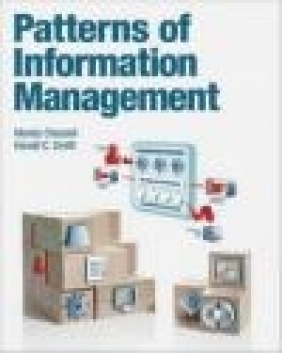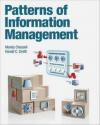Patterns of Information Management
Harald Smith, Mandy Chessell
Patterns of Information Management
Harald Smith, Mandy Chessell
- Producent: IBM Press
- Rok produkcji: 2013
- ISBN: 9780133155501
- Ilość stron: 736
- Oprawa: Twarda
Niedostępna
Opis: Patterns of Information Management - Harald Smith, Mandy Chessell
Use Best Practice Patterns to Understand and Architect Manageable, Efficient Information Supply Chains That Help You Leverage All Your Data and Knowledge In the era of "Big Data," information pervades every aspect of the organization. Therefore, architecting and managing it is a multi-disciplinary task. Now, two pioneering IBM(R) architects present proven architecture patterns that fully reflect this reality. Using their pattern language, you can accurately characterize the information issues associated with your own systems, and design solutions that succeed over both the short- and long-term. Building on the analogy of a supply chain, Mandy Chessell and Harald C. Smith explain how information can be transformed, enriched, reconciled, redistributed, and utilized in even the most complex environments. Through a realistic, end-to-end case study, they help you blend overlapping information management, SOA, and BPM technologies that are often viewed as competitive. Using this book's patterns, you can integrate all levels of your architecture-from holistic, enterprise, system-level views down to low-level design elements. You can fully address key non-functional requirements such as the amount, quality, and pace of incoming data. Above all, you can create an IT landscape that is coherent, interconnected, efficient, effective, and manageable. Coverage Includes * Understanding how a pattern language can help you address key information management challenges * Defining information strategy and governance for organizations and users * Creating orderly information flows you can reuse and synchronize as needed * Managing information structure, meaning, and lifecycles * Providing for efficient information access and storage when deploying new IT capabilities * Moving information efficiently and reliably to support your processes * Determining how information should be processed and maintained * Improving quality and accessibility, and supporting higher-value analytics * Protecting information via validation, transformation, enrichment, correction, security, and monitoring * Planning new information management projects in the context of your existing IT resourcesAbout the Authors xxix Chapter 1 Introduction 1 Islands of Information 1 Introducing MCHS Trading 2 Improving an Organization's Information Management 4 Patterns and Pattern Languages 7 Basic Components in the Pattern Language 11 Information Integration and Distribution 12 Pattern Language Structure 15 Summary 22 Chapter 2 The MCHS Trading Case Study 25 Introduction 25 Building an Information Strategy 26 Creating Management Reports 28 Creating a Single View of Product Details 30 Creating a Single View of Customer Details 37 Understanding the Status of Orders 44 Delivering Information Quality Improvements 47 Connecting MCHS Trading into a B2B Trading Partnership 51 Exploiting Predictive Analytics 55 Summary of Case Study 67 Chapter 3 People and Organizations 69 Information Centric Organization Patterns 70 Information Centric Organization 73 Information Management Obligation 78 Information Management Strategy 81 Information Management Principle 83 Information Governance Program 88 Information User Patterns 91 Information User 92 Variations of the Information User Pattern 95 Summary 97 Chapter 4 Information Architecture 99 Information Element Patterns 100 Information Element 101 Entity-Level Information Elements 106 Information Asset 107 Information Activity 110 Information Event 113 Information Processing Variables 114 Information Summary 117 Message-Level Information Elements 119 Information Payload 119 Attribute-Level Information Elements 122 Information Link 123 Information Metric 124 Information Code 126 Summary of Information Elements 129 Information Identification Patterns 129 Information Identification 130 Defining Which Information to Manage and How 133 Subject Area Definition 134 Valid Values Definition 136 Information Configuration 139 Defining How Information Is Structured 141 Information Model 141 Information Schema 143 Locating the Right Information to Use 145 Information Location 146 Semantic Tagging 148 Semantic Mapping 150 Different Reports About Information 153 Information Values Report 154 Information Values Profile 156 Information Lineage 159 Summary of Information Identification 161 Information Provisioning Patterns 161 Information Provisioning 163 Localized Provisioning 166 User Private Provisioning 167 Application Private Provisioning 169 Process-Level Provisioning 171 Daisy Chain Provisioning 172 Service-Level Provisioning 177 User Shared Provisioning 178 Service Oriented Provisioning 179 Linked Information Provisioning 182 Cache Provisioning 184 Collection-Level Provisioning 185 Snap Shot Provisioning 186 Mirroring Provisioning 189 Peer Provisioning 193 Event-Based Provisioning 196 Recovery Provisioning 197 Summary of Information Provisioning 199 Information Supply Chain Patterns 199 Information Supply Chain 200 Variations of the Information Supply Chain Pattern 209 Cascading Information Supply Chain 211 Hub Interchange Information Supply Chain 215 Single View Information Supply Chain 219 Consolidating Information Supply Chain 223 Hierarchical Information Supply Chain 225 Peer Exchange Information Supply Chain 230 Summary of Information Supply Chains 232 Summary 232 Chapter 5 Information at Rest 235 Information Service Patterns 236 Information Service 238 Information Service Implementation Patterns 243 Local Information Service 243 Remote Information Service 246 Triggering Information Service 250 Summary of Information Services 253 Information Collection Patterns 253 Information Collection 254 Location of Information 259 Physical Information Collection 260 Virtual Information Collection 263 Usage of an Information Collection 266 Master Usage 267 Reference Usage 271 Hybrid Usage 274 Sandbox Usage 277 Scope of an Information Collection 279 Complete Scope 280 Local Scope 282 Transient Scope 284 Coverage of an Information Collection 285 Complete Coverage 285 Core Coverage 286 Extended Coverage 286 Local Coverage 287 Summary of Information Collections 287 Information Entry Patterns 288 Information Entry 289 Identifying Information Using the Information Key 292 Information Key 295 Local Key 297 Recycled Key 300 Natural Key 302 Mirror Key 305 Aggregate Key 307 Caller's Key 310 Stable Key 312 Structures for an Information Entry 316 Locking for an Information Entry 317 Specialized Operations for an Information Entry 317 Summary of Information Entries 318 Information Node Patterns 319 Information Node 320 Business Information Nodes 324 Application Node 326 Information Content Node 330 Search Node 332 Information Store 334 Information Mart 337 Information Cube 340 Integration Nodes 343 Information Broker 343 Queue Manager 349 Staging Area 353 Look-Up Table Node 356 Event Correlation Node 358 Operational Data Stores and Hubs 360 Information Mirror Store 361 Information Event Store 364 Operational Status Store 366 Information Asset Hub 368 Information Activity Hub 372 Big Data Information Processing Nodes 376 Information Warehouse 377 Streaming Analytics Node 380 Map-Reduce Node 382 Analysis Information Nodes 385 Information Analysis Node 386 Information Mining Store 389 Summary of Information Nodes 393 Summary 394 Chapter 6 Information in Motion 395 Information Request Patterns 396 Information Request 396 Variations of the Information Request Pattern 398 Summary of Information Requests 401 Information Flow Patterns 401 Information Flow 403 Routing Information Flows 406 Staged Routing 407 Partitioned Routing 410 Buffered Routing 413 Filtered Routing 416 Summarized Routing 418 Consolidating Information Flows 420 Synchronized Consolidation 421 Filtered Consolidation 424 Ordered Consolidation 427 Independent Consolidation 429 Distributing Information Flows 432 Synchronized Distribution 433 Partitioned Distribution 436 Ordered Distribution 439 Independent Distribution 441 Broadcast Distribution 444 Summary of Information Flow Patterns 446 Summary 447 Chapter 7 Information Processing 449 Information Trigger Patterns 450 Information Trigger 450 Variations of the Information Trigger Pattern 453 Manual Information Trigger 453 Scheduled Information Trigger 455 Information Service Trigger 458 Information Change Trigger 460 External Sensor Trigger 462 Summary of Information Triggers 465 Information Process Patterns 465 Information Process 466 Business Processes 469 Bespoke Application Process 471 Packaged Application Process 472 Agile Business Process 474 State Driven Process 476 Collaborative Editing Process 479 Information Reporting Process 481 Quality Information Processes 483 Information Profile Tracking Process 484 Clerical Review Process 487 Information Remediation Process 489 Information Validation Process 491 Information Matching Process 493 Information Ever-Greening Process 496 Information Archiving Process 497 Provisioning Information Processes 499 Information Replication Process 500 Information Deployment Process 502 Information Relocation Process 505 Information Federation Process 507 Information Queuing Process 509 Information Broadcasting Process 511 Information Summarizing Process 513 Information Scavenging Process 515 Analytics Processes 517 Information Pattern Discovery Process 518 Information Decision Definition Process 521 Information Pattern Detecting Process 523 Search Processes 525 IT Service Management Processes 526 Operational Health Monitoring Process 527 Information Node Management Process 528 Scheduling Process 530 Summary of Information Processes 531 Summary 532 Chapter 8 Information Protection 533 Information Reengineering Step Patterns 534 Information Reengineering Step 534 Specialist Information Reengineering Steps 538 Restructure Data 539 Standardize Data 542 Enrich Data 545 Classify Data 546 Check Data 548 Correct Data 550 Link Entries 553 Merge Entries 556 Separate Entries 558 Derive Value 560 Derive Relationship 562 Smooth Data 563 Sample Data 565 Information Guard Patterns 566 Information Guard 567 Variations of the Information Guard Pattern 570 Information Probe Patterns 572 Information Probe 572 Variations of the Information Probe Pattern 575 Summary 576 Chapter 9 Solutions for Information Management 577 Information Solution Patterns 578 Information Solution 578 Patterns for Changing Information Nodes 582 New Information Node 583 Information Node Upgrade 587 Patterns for Integrating Information Nodes 590 Distributed Activity Status 590 Semantic Integration 593 Partner Collaboration 597 Patterns for Master Data Management 599 Shared Master 601 Centralized Master 604 Information Registry 607 Golden Reference 610 Synchronized Masters 613 Patterns for Big Data and Warehouses 618 Historical System of Record 619 Workload Offload 624 Patterns for Business Intelligence and Analytics 626 Performance Reporting 626 Operational Analytics 628 Next Best Action 630 Patterns for Information Protection 633 Managed Archive 634 Information Access Audit 636 Information Monitoring 638 Summary of Information Solutions 642 Final Thoughts 642 Appendix 1 Glossary 643 Appendix 2 Summary of MCHS Trading's Systems 649 Appendix 3 Related Pattern Languages 651 Appendix 4 Bibliography 653 Information Centric Organization 653 Enterprise Architecture 653 Enterprise Application Architecture 654 Service-Oriented Architecture and Web Services 655 Information Architecture 655 Data Models 655 Metadata Management 656 Information Warehouse 657 Information Integration 657 Information Quality 658 Master Data Management 659 Big Data 659 Analytics and Reporting 660 Information Security and Privacy 660 Information Life-Cycle Management 661 Patterns Index 663 Index 669
Szczegóły: Patterns of Information Management - Harald Smith, Mandy Chessell
Tytuł: Patterns of Information Management
Autor: Harald Smith, Mandy Chessell
Producent: IBM Press
ISBN: 9780133155501
Rok produkcji: 2013
Ilość stron: 736
Oprawa: Twarda
Waga: 1.27 kg




















